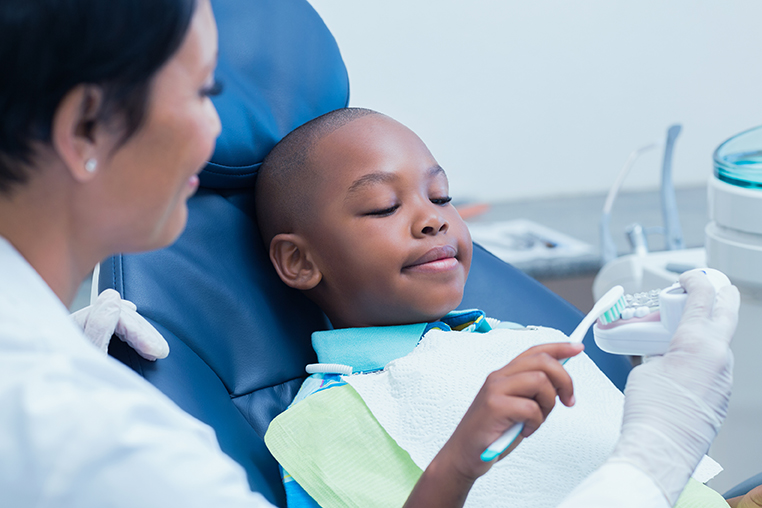Brushing and Toothpaste for Children
Even before your child's teeth have come in, it's important to start mouth care. Using a damp washcloth or piece of gauze, gently rub it over your infant's gums to help clean the mouth. Brushing your child's teeth should begin when the first tooth appears. Use a small amount of fluoride toothpaste, about the size of a grain of rice, on a soft-bristled toothbrush. When your child is about 3 years old, you can use a pea-sized amount of toothpaste. Your child will need help brushing their teeth until about age 7 or 8.

The importance of brushing
The single best way to remove harmful plaque from teeth and gums is to brush teeth regularly and correctly. At least twice a day is advised. Plaque is a thin, sticky film loaded with bacteria.
What is the correct method for teeth brushing?
Every mouth is different, and there is more than one effective way to brush. Deciding which way is best for your child depends largely on their teeth positions and gum condition. Talk with your child's pediatric dentist or primary care provider to decide which brushing method is best for your child's mouth.
Generally, most healthcare providers advise the following method:
-
Step 1. Place the toothbrush beside the teeth at a 45-degree angle to the gums.
-
Step 2. Gently brush back and forth in a short, tooth-wide motion. Brush vertically with up-and-down strokes to brush the backs of the front teeth.
-
Step 3. Brush the outside of the teeth, inside of the teeth, and the chewing surfaces.
-
Step 4. Gently brush the tongue to remove bacteria and freshen breath.
-
Step 5. Repeat steps 1 through 4 at least twice daily, especially after meals and snacks.
What type of toothbrush should be used?
Use a child-sized toothbrush. The brush should have a handle suitable for firm grasping. The bristles of the brush should be soft, nylon, and rounded at the ends. This helps ensure that the brush bristles are gentle to the gums and tooth surfaces. Soft, polished bristles let you reach into the crevice between the teeth and gums to remove plaque without damaging the gums. Some brushes are too abrasive and can wear down the tooth enamel. So, in most cases, medium and hard bristles are not advised. Only gentle pressure is needed when brushing to remove the plaque. Too much pressure can cause the gums to recede and can wear away the tooth surface.
How often should you brush?
Generally, brushing is advised twice a day for at least 2 minutes each time. People often think they are brushing long enough. But in fact, most people spend less than 1 minute brushing. In addition, it is generally better to brush 2 minutes twice a day instead of brushing quickly 5 or more times during the day.
It's important to brush teeth during the day while at school or play. Keeping a toothbrush handy, in a desk or backpack, increases the chance that your child will brush during the day. Make brushing before bedtime and in the morning a routine part of your child's day.
Facts about toothpaste
Brushing with toothpaste (particularly toothpaste with fluoride) helps to:
Always oversee children to make sure they use the correct amount of toothpaste. Encourage your child to spit toothpaste out as much as possible after brushing.
Which type of toothpaste is best?
Fluoride is the most crucial ingredient in toothpaste. As long as the toothpaste contains fluoride, the brand or type (paste, gel, or powder) generally does not matter. All fluoride toothpastes work effectively to fight plaque and cavities, and to clean and polish tooth enamel. The brand you choose should have the American Dental Association (ADA) seal of approval on the container. This means that clinical trials have shown adequate evidence the product is safe and effective.
Some toothpastes offer tartar control pyrophosphates to prevent the buildup of hard calculus deposits on teeth. Others offer whitening formulas to safely remove stains, making teeth brighter and shinier. But fluoride is the true active ingredient that works the hardest to protect your child's teeth.
Contact your child's healthcare provider if you have any questions about brushing or toothpaste. Schedule a dental appointment for your child no later than their first birthday.